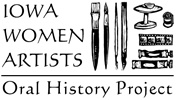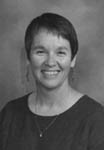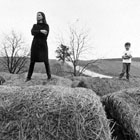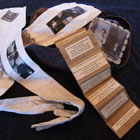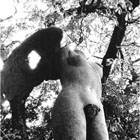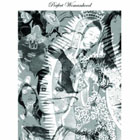ROBBIE STEINBACH
artwork | audio | statement | 2008 update
artwork
audio 
(see also Making Art in Iowa)
note: I interviewed Robbie in a bustling coffeehouse in Des Moines, so at times, the ambient noise in these clips is rather loud!
- Early Art (73 sec. | 572KB): listen | read
- Discovering (74 sec. | 580KB): listen | read
- Grad School (83 sec. | 655KB): listen | read
- Women's Lives (49 sec. | 387KB): listen | read
- Art as Passport (60 sec. | 470KB): listen | read
- Advice (29 sec. | 231KB): listen | read
artist statement
Since 1985, my photographic work has examined women's lives. I began with self-portraits, taken during a time of change in my life. That work soon extended to photographs of other women in their homes. I wanted to make their work and lives visible. Women are still faced with an ambiguous status in our society, as many of their roles change, and many traditional expectations remain. Photography, with its apparent realism and its rendition of static detail, gives me a way to question and record the complexities of women's lives.
A similar motivation led me to begin my "women artists in Iowa" project in 1991. The work of women artists has long been underrepresented and undervalued. My collection of portraits resists the myth that successful women artists are anomalies. The Iowa women I picture are among the many talented artists who have built thriving artistic careers, often while juggling numerous roles as teachers, mothers, businesswomen, etc. They are shown as strong, intelligent, determined and beautiful women. My photographs defy the tradition of imaging women as beautiful objects. The women in these portraits are creative, not created.
In 1998 I self-published Lifework: Portraits of Iowa Women Artists. This book was a collaborative project "birthed" by a volunteer editor and designer, numerous essay writers, funding angels, and the artists themselves.
It seems that I always come back to portraits of women. Although I also photograph other subjects—my travels, details of nature, etc., I continue to be disturbed by the ways in which women are portrayed in American popular culture. Just when I think progress is being made, I'll be assaulted by yet another image of an emaciated scantily-clad young woman upside down in a garbage can, her lifeless feet advertising the latest fashion in shoewear. I become angry, and I feel the need to create images of authentic beautiful and intelligent women.
I have recently been photographing creative women—visual artists, musicians, writers—in Taos, New Mexico. When I first discussed this artistic project with a friend, she suggested I call it by the acronym SIWOT, Strong Independent Women of Taos. That has been its working title since then. Eventually, it will be a book with text by my friend, writer Lyn Bleiler. She and I have been granted a residency by the Emily Harvey Foundation in Venice, Italy, for summer 2009, to work on editing and shaping this project.
2008 update
In 1999, I resigned from my job at Augustana College due to air quality problems in a new art building. I continued my art, made a pilgrimage to Italy that resulted in the photos on this site, worked in a bookstore, and made plans to move to New Mexico. That longtime dream was realized in 2001.
My husband and I built a home in this incredibly beautiful place, and I am teaching at The University of New Mexico–Taos. I recently had a one-woman show of prints and artist books at the Millicent Rogers Museum here. This new life is good.
(from artist's statement below)
I have recently been photographing creative women—visual artists, musicians, writers—in Taos, New Mexico. When I first discussed this artistic project with a friend, she suggested I call it by the acronym SIWOT, Strong Independent Women of Taos. That has been its working title since then. Eventually, it will be a book with text by my friend, writer Lyn Bleiler. She and I have been granted a residency by the Emily Harvey Foundation in Venice, Italy, for summer 2009, to work on editing and shaping this project.
audio text
Early Art
After my father died, my mother loaded my sister and me in the car and drove all the way to Colorado, which was an amazing thing, because she only learned to drive in her early forties. But I think she was so desperate to see her sister who lived in Colorado. We had a little Hawkeye Brownie camera—one of those little box cameras—and so she gave it to me to take a few pictures with. And I was standing on a rock in the Colorado River—on edge of the river—and the latch came loose and the part of the camera with all of the film in it came out and rolled down the river. So, it was not a good beginning to my life as a photographer.
Actually, the last time I took an art class was eighth grade. I think this woman who was teaching art was basically a musician who was forced to teach some art classes, didn't like doing it. She was horrible. I remember once she gave us an assignment to go draw something for the entire class period. So I went outside the old junior high and I drew this ornate wooden door. I thought it was great, because I spent a lot of time and it looked to me pretty much like the door looked. I went in—and I'll never forget this—she said, "That's not at all what it looks like." And I didn't do any art again until I was in my thirties.
Discovering
I always thought I would be an English major, because I always loved to read and I was really good at English classes. And I thought that women really could be housewives, nurses, or teachers…and secretaries. So teacher sounded like the best alternative for me.
During my last years of teaching at Coolidge Junior High in Moline, I had the opportunity to go two summers with the People to People high school student ambassador program. We went to seven different countries in five-and-a-half weeks. The first trip I had just a little 126 Instamatic camera, and I was so disappointed with the photographs when I came back. So I bought a basic manual camera, and I went off again to Europe. I still didn't get very good pictures, because I really didn't know what I was doing. But I sort of remember the moment that my love of it started. I was at Schoenbrunn Palace in Vienna, and I decided instead of taking the same picture everybody else was taking, to go behind this waterfall which you could walk behind, and shoot the palace through the water. The photograph is not that great, but I just remember thinking, Cool! This is fun! So when I came home I took a photo class at the Davenport Museum of Art, and then I never stopped.
Grad School
When my daughter was six, I commuted with a friend who was taking classes. I just felt like I needed more in my life. So I thought, Well, I'll take this one class. And I loved it. It just opened up this whole world of art photography that I didn't even know existed. So then I decided I wanted to actually get a degree—an M.A. and an M.F.A. So I commuted back and forth for five-and-a-half years and got my two degrees. I'm very glad I did it, I mean, it changed my life, but it was very stressful and I was exhausted all the time.
Probably the most influential class I took wasn't a photography class. It was a class taught by Ann Roberts called Gender and Image in Medieval and Early Renaissance Art. She's an amazing teacher and it really opened my eyes to a lot of things. I mean, I definitely started becoming a feminist when I was in graduate school, although I'd certainly had the leanings before. Because it talked about the way that things like religion, which previously had been unexamined in my life, contributed to women's secondary status in our society. In fact, I even ended up doing an artwork based on a 17th century woodcut called The Wise Woman. And it's a Catholic portrayal of what a wise woman should be. So I ended up doing a series of self-portraits parodying this. It was a lot of fun and felt very empowering.
Women's Lives
Growing up in the fifties, I had all of these preconceptions about who I should be and what I should be doing, you know, all of those things that a lot of us grew up with who are my age. But yet I was being influenced by the women's movement and seeing that there was much more. So when I was taking these early self-portraits and going around and photographing other women in their homes, I think I was trying to figure out what's important and what isn't, what do I want to keep, what do I want to discard? And I was interested in how other women were doing these things. I found that the women I was most interested in were the artists. How do they do it? Especially the ones who were juggling families and jobs and things like I was. I started concentrating on artists. And then eventually thought, this should be a real project, and just kept going with it. But it's always been about women's lives and how we're figuring out what we want to do and who we want to be.
Art as Passport
When I'm wandering around the Iowa landscape or I'm talking to some artist and learning things and enjoying being with them—that's actually more important than the actual photos. I mean, the photos are a record of that and they're good because you can communicate to somebody else some of what you felt at that time, but the process of doing the photography is the most important part.
Diane Arbus talked about the camera as a passport into other worlds, and it has been that for me. I'm just very grateful that I found art. I don't think I'd be very happy if I were still teaching junior high English. I like the people I've met because of being an artist—especially the other artists. I like the places it's taken me. So I'm really happy I found it, and sometimes it's scary to think about, what would have happened if I hadn't gone on that trip and decided to buy a camera. It also makes you think, too, about how you make these choices in your life that you don't know the consequences of, good or bad—luckily, because life would be pretty boring if you did. But how exciting to think about, you make this one choice and it leads to this.
Advice
Be very determined. Anne Noggle said that to me years ago, because I was pretty new as an artist and trying to feel my way. She said, "There are a lot of people who have talent. The ones that make it are really determined." And that you have to carve out that time to do it. Some people have this stereotype of artists as these really flaky people—I think artists are the most self-disciplined people I know. You have to be. There's nobody saying, You have to have this done by five o'clock today. So, I think that I'd say to a young artist, Just keep working at it.
